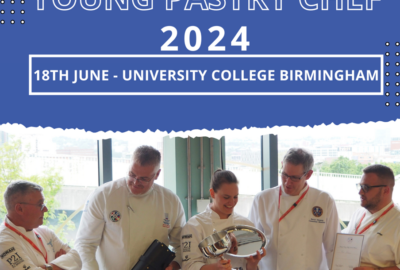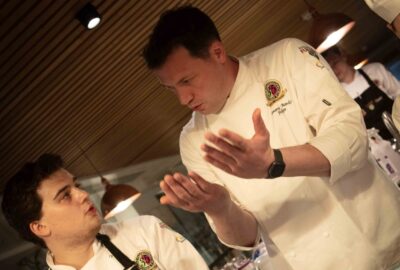Minimal cost ideas that add value to your dishes – so you can maximise your profit
Here, six professional chefs and food experts share their tips and ideas on how they have enhanced and added value to a dish – from seaweed to spun sugar – without breaking the bank!
Phil Fanning head chef & owner of Michelin-starred Paris House, Woburn, Bedfordshire Seaweed comes in all shapes, colours, textures and sizes. There are a range of flavours, some with strong mineral characteristics and others with much more subtle vegetable or salad flavours. With such a variety out there I find myself using seaweed in all sorts of situations, Wakame, sea beans and sea lettuce pair very well with cooked fish, Tosaka and Sea grapes with raw fish and Kombu and red dulse works very well with cooked meats, to name but a few. Often seaweed can be bought in a dried form allowing you to rehydrate and use the amount you require as needed which keeps wastage to a minimum. More often than not seaweeds are visually interesting allowing you to add colour and textural appeal to a dish whilst adding an interesting flavour at the same time. This low cost ingredient can enhance flavour, texture and aesthetics and help elevate a dish to the next level.
Colin Gibbons, event chef, The Three Crowns, Wisborough Green, West Sussex Being in a rural village and on the iconic A272 we get lots of passing trade, but a large part of the pub’s success is the very social local community, which is an eclectic mix. Our objectives are to serve up great, tasty food, to keep regulars coming back and to make a decent profit margin. Our aim is to get the prices and quality balanced, to keep the locals keen. We don’t want to get complacent, and this is the secret to our success. Adding seasoned chips, using Schwartz Chip Seasoning, to our menus keeps things fresh, offers customers an element of surprise and enhances our food with an exciting, extra dimension. We’ve started offering chip seasoning as an upgrade for customers ordering chips; we also add it to mash and use it on roast potatoes which we leave out on the bar and get really good feedback.
Paul Porter, owner of The Fox Inn, Great Barrington, Oxfordshire Whilst being a complex and skillful process, spun sugar is something that can be added to a dessert which can instantly enhance a dish. This technique really impresses customers and as well as looking great, it shows off the skills of the chef. The beauty of this is it is only a combination of sugar and water, so minimum cost for maximum effect. Another simple but effective technique you can use is a smear of chocolate or coulis to decorate the plate. It’s like painting a picture. If you can view it as art, others will too. This method is simple and creates the most wonderful designs, also helping to give the dish that wow factor.
Ben Davy, executive chef, Ox Club, Leeds We get excellent value from guinea fowl by using the whole bird for a variety of things. We brine the breast and use them for a grill dish, the legs are salted and cooked confit, the meat is then used on both the grill breast dish and on the brunch menu in a cassoulet. The cooked leg skin is dehydrated and fried to make crackling. The wings are cooked confit, deboned, floured and deep-fried as fun little boneless canapés. Finally the carcass is used to make a great little stock which we use across several other dishes.
Lorna Simpson, senior foodservices consultant for Eagle Solutions Services, school food management consultancy based in London There is no question that children eat with their eyes. Once a plate is placed in front of a child within seconds they have already passed judgment on how that food is going to taste. You don’t necessarily have to go overboard to make a great presentation just keep it simple and use produce that are in season to educate the children. School catering managers should ensure that the vegetables, proteins and vegetarian options work well together in terms of colour, shape and texture to improve presentation. The contrast of the vegetables on a plate makes so much difference. By focusing on these elements, other aspects of the dish, such as the accompanying seasonal vegetables or sauce, will help to make the food attractive. Garnishes on a plate should have a purpose and be edible. Younger children will not enjoy a strong taste such as uncooked rosemary, which is not easily digested, instead use things like sprigs of parsley, cucumber, tomatoes, carrots or spring onions, sliced very thinly.
Dick Van Leeuwen, AHDB Beef & Lamb’s master butcher If the price of more popular cuts becomes prohibitive, chefs should try alternative, added value options, rather than shy away from beef and lamb. Chefs don’t need to disregard beef to keep prices down; they just need to look at a variety of added value options. With hundreds of beef and lamb cuts available, there really is something for every establishment. We have developed many cuts from the forequarter of the beef carcase and other under-utilised primals using seam butchery techniques. This maximises use of the carcase and enhances profit opportunities for the whole supply chain. Our Excellence in Steak range includes traditional steaks such as the Rib-Eye which has been highly trimmed, as well as a number of quality, added value alternatives such as the Flat Iron and Denver from the forequarter and Bistro Rump, Centre Cut and Picanha from the hindquarter, giving chefs and their customers plenty to choose from. Many of these cuts are already popular in the marketplace, with steaks such as the Flat Iron becoming a standout success. Using alternative steak cuts not only provides profit opportunities for caterers but adds real differentiation to menus too. Other more traditional cuts such as the beef shin can also be used creatively to create interesting, more cost-effective dishes.


